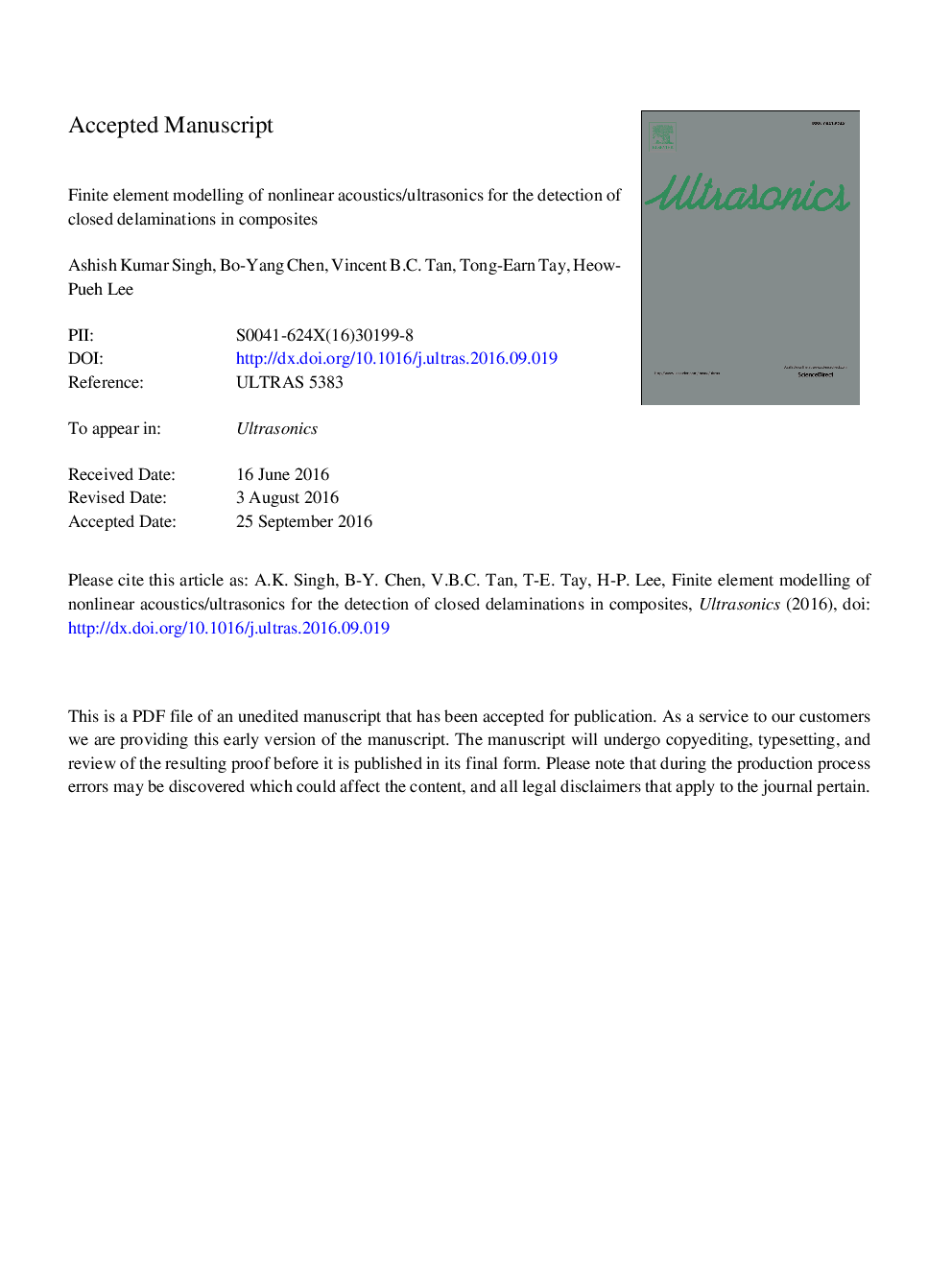| کد مقاله | کد نشریه | سال انتشار | مقاله انگلیسی | نسخه تمام متن |
|---|---|---|---|---|
| 5485307 | 1523195 | 2017 | 45 صفحه PDF | دانلود رایگان |
عنوان انگلیسی مقاله ISI
Finite element modeling of nonlinear acoustics/ultrasonics for the detection of closed delaminations in composites
ترجمه فارسی عنوان
مدل سازی عنصر محدود از آکوستیک های غیرخطی / اولتراسونیک برای تشخیص خسارت های بسته در کامپوزیت ها
دانلود مقاله + سفارش ترجمه
دانلود مقاله ISI انگلیسی
رایگان برای ایرانیان
کلمات کلیدی
آکوستیک غیرخطی / اولتراسونیک، مدل سازی و شبیه سازی، تماس با غیر خطی صوتی خستگی های بسته اوراق قرضه بوسیدن،
ترجمه چکیده
روشهای اولتراسونیک خطی براساس اصل انعکاس، انتقال، تخلیه امواج صوتی به طور سنتی برای شناسایی خسارات در ساختارهای کامپوزیتی استفاده شده است. با این حال، وقتی که خوشه بندی در مراحل اولیه بسیار شبیه به تقریبا بسته یا بسته به دلیل بار فشاری است، روش های خطی ممکن است نتواند چنین مواردی را شناسایی کند. آکوستیک های غیرخطی / اولتراسونیک توان بالقوه برای شناسایی آسیب در ساختارهای کامپوزیتی دارند که برای تشخیص با استفاده از روش های اولتراسونیک خطی معمولی مشکل است. روش غیرخطی شامل تحریک ساختار با سیگنال سینوسی از فرکانس خاص (یا چندگانه) و مشاهده ارتعاشات ساختار است. ارتعاش ناحیه خسارت به طور قابل توجهی از مناطق آسیب دیده متفاوت است و می تواند برای شناسایی آسیب ها مورد استفاده قرار گیرد. با این حال با توجه به ماهیت پیچیده و متفاوت پدیده های غیر خطی ایجاد شده توسط تعامل بین سیگنال هیجان انگیز و آسیب، متغیرهای زیادی در بازی وجود دارد که می تواند منجر به موفقیت یا شکست روش شود. در حالی که آزمایشات منجر به ایجاد روش به عنوان یک روش تشخیص آسیب می شود، شبیه سازی عددی می تواند به توضیح پدیده های مختلف مرتبط با غیر خطی کمک کند. این کار یک رویکرد سریع را برای مدل سازی رفتار غیرخطی ناشی از خسارت های بسته ارائه می دهد. مدل با رویکردی که قبلا برای مدلسازی ارتعاشات غیرخطی مورد استفاده قرار گرفته است، مقایسهای انجام شده است. ماهیت محلی غیر خطی، امکان تعیین منطقه آسیب در ساختار را فراهم می کند. علاوه بر این، چندین مطالعه پارامتری برای مطالعه اثر پارامترهای مختلف مربوط به پدیده غیرخطی انجام شده است.
موضوعات مرتبط
مهندسی و علوم پایه
فیزیک و نجوم
آکوستیک و فرا صوت
چکیده انگلیسی
Linear ultrasonics methods based on the principle of reflection, transmission, dissipation of sound waves have been traditionally used to detect delaminations in composite structures. However, when the delamination is in very early stages such that it is almost closed, or closed due to a compressive load, the linear methods may fail to detect such cases of delaminations. Nonlinear acoustics/ultrasonics have shown potential to identify damages in composite structures which are difficult to detect using conventional linear ultrasonic methods. The nonlinear method involves exciting the structure with a sinusoidal signal of certain (or multiple) frequency and observing the vibrations of the structure. The vibrations of the damage region differ significantly from intact regions and can be used to identify the damage. However due to the complex and varying nature of the nonlinear phenomena created by the interaction between the exciting signal and the damage, there are many variables at play which can lead to success or failure of the method. While experiments lead to the establishment of the method to be used as a damage detection technique, numerical simulations can help to explain the various phenomena associated with nonlinearity. This work presents a quick approach to model the nonlinear behavior caused by closed delaminations. The model is validated with a previously available approach for nonlinear vibrations modeling and a comparison is made between the two. The local nature of the nonlinearity enables to map out the area of damage in the structure. Additionally, a few parametric studies are performed to study the effect of various parameters related to the nonlinear phenomenon.
ناشر
Database: Elsevier - ScienceDirect (ساینس دایرکت)
Journal: Ultrasonics - Volume 74, February 2017, Pages 89-98
Journal: Ultrasonics - Volume 74, February 2017, Pages 89-98
نویسندگان
Ashish Kumar Singh, Bo-Yang Chen, Vincent B.C. Tan, Tong-Earn Tay, Heow-Pueh Lee,
